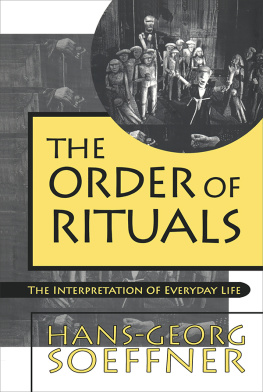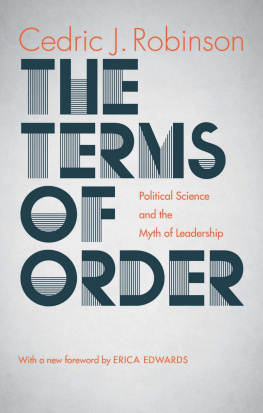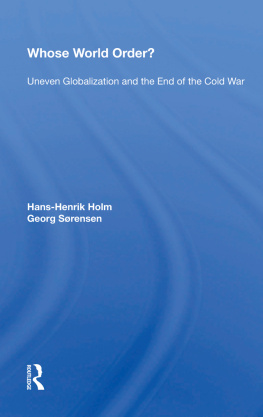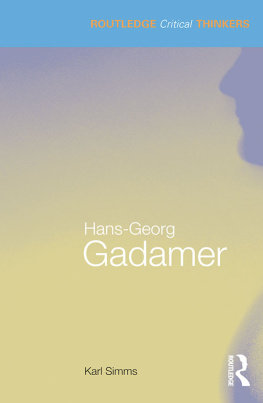How Rituals are Ordered and the Order of Rituals
The question of the subject is woven into the network of contemporary social theorys themes whose concepts and contents shine brightlysystem and lifeworld; constructivism and deconstruction; discourse, code, and differenceas central line of inquiry, general theme, and leitmotif at the same time. It is the inquiry into the here and beyond of systems, codes, and discourses; into the names of the authors; into the concrete, materially incarnate place in which it thinks, writes, acts, and processes; into the agency that makes and must make a distinction between an I and an other.
The implicit and explicit ubiquitousness of this question is a reason, in the market of theories and schemes, why the deconstruction of the subject finds itself in immediate proximity to a simultaneously asserted, inflationary individualism (individualization of lifestyles, life situations, life stories, etc.). Moreover, as a result of the emphasis on a de-subjectivization of the theory, the subject who is supposed to have disappeared is theorized upon more fervently than ever. Finally, the observer of markets can enjoy the perfect presentations in which the theoreticians of subject-free concepts stage themselves as a decorated empty space for their theories: as bodily performatory existence of that which is not supposed to exist.
Turning to the order of symbols and rituals in the face of this situation could easily be mistaken for an attempt to enrich the deconstruction of the subject by yet another variant or by the analyses of discourse codifications. Yet nothing could be further from my intentions in the following chapters. Instead, my aim is, on the one hand, to pursue selected tracks on the paths to the contemporary belief or hope in an autonomous social subject. On the other hand, I shall also search for partial answers to the question of what efforts of order and orientation hold individualistically organized (purportedly atomized) societies together. In doing so, I shall focus on those symbolic forms of (self-)presentation which at present permit us to bring enough order and clarity into the new lack of clarity conjured up by social critics (e.g. Habermas) that we feel quite comfortable in it.
Our society presents itself as unclear and unmanageable to all those who were (or are) still accustomed to seeing social order depicted in classes, strata, central groups or institutions, and who measure and classify the social world(s) according to centers and margins. But human societies get caught up time and again in situations in which the traditional grids of order and stratifications lose their value and no longer serve as orientation for the individual. Situations like those can be found in the sixteenth and at the close of the eighteenth centuries in Central Europe, in which old orders give way to new ones, the social balance of power shifts, traditional hierarchies crumble and are replaced or destroyed by others.
Our times are not so very different structurally from those predecessors. Thus, in the United States, one has been able to observe for a long time now the development of a social structure pattern that is increasingly gaining importance in Western Europe, too: The social rise and fall of individuals is regulated less and less by stable, hereditary membership in classes or groups. The elevators of vertical mobility can no longer be rented beforehand and used exclusively by specific social groups. Drop-ins and drop-outs now belong to other and very various groups. They are evaluated more according to their future than according to their provenance. In addition, the homemade mixture of Western societies through global migrations receives a further, only temporarily external component: Mobility and variety, opposing interests and conflicts, dissimilarity and inequality, mass concentration and isolation, mechanisms of merging and exclusion are characteristic of these societies. The individual has to perform his own self-classification since the existing relations are losing their value. He has to make himself so recognizable by actions and external presentation as a member of something and as belonging to something that, tendentially, anyone can classify him without having ever seen him and without knowing him personally.
The combination of other and self-observation, of social presentation and self-staging, gains importance in these societies: They are, more than others, societies of observation and staging. The repertoires and styles of presentation become insignia of lifestyles. These for their part signal not only consumer habits, but also membership in collective attitudes in terms of conduct and value systems. Forms of presentation as elements and instruments of orientation put their special mark on the mixed societies.
As in historical situations of social re-formation, those guarantors of social orientation now appear in which social order becomes visible as a social product that is constantly to be renewed, and as an act of presentation by each individual member of society. Thus, frequent council decrees regulating clothing enjoyed their zenith precisely in those times in which the estate system collapsed: The willed (new) self-classification replaced the matter-of-course that was traditional and anchored in routines.
Emblems, fashions, styles in staging, and the search for new symbols for a while replaced the corporative social order just as they later, time and again, were to replace the orders of classes or strata. The attempt to replace privilege, class, or strata-specific formations of demeanor with the help of ritualized or ritualizable rules of conduct stems from the same source, from Castiglione to Knigge and Pappritz, all the way to contemporary how-tos for stylish conduct.
This gives rise to the suspicion that economically, culturally, and ethnically mixed societies not only replace an old order through their return to specific, visible forms of presentation, but that they present themselves and their world views in them: as a public stage of lifestyles, attitudes, and demeanor, interests and worldviews, generally available to all. This stage hardly knows permanently distinguishablethrough office or originperformers any more. The stage is at the same time medium, market, and arena: the place in which every social formation, in fact everyone, must appear and present itself, himself, herselfinsofar as they wish to hold their own in the face of the competition. Success on stage, however, comes only to those who are able to let their presentation become an element of a collectively recognized and all-embracing order.











